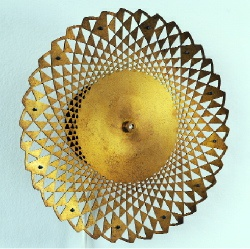The works in Katja Strunz' sparse constellations often appear to have been spared an uncertain fate or narrowly escaped a traumatic event, and found safehaven in a gallery. While they have a marked retro flair and draw on Modernist sculptural and graphic traditions - without resorting to irony, parody or revisionist zeal - their existence isn't an untroubled one. Signs of fatigue, ageing or wear-and-tear testify to this. Her abstraction seems tainted by a Romantic, Gothic sensibility that proposes the expression of world-weariness as one viable response to the state of things.
A number of Strunz' works on paper involve subtle reworkings of forlorn black-and-white found images. In o.T. (Untitled, 1998) she blacked out the shape of a racing yacht, turning it into a jagged abstract weight suspended in a watery twilight. It looks like a crepuscular phantom, a floating monolith that has lost its bearings, permanently adrift. The mood recalls Arnold Böcklin's painting the Isle of the Dead (1880-6), which depicts a funeral barge on its way to a rocky cypress-dotted citadel.
Much of Strunz' work has this kind of dark, brooding intensity. Her favoured materials, which include found timber, scrap metal, acid-yellowed pages and landscape photographs culled from books, are not so much recycled as resuscitated. Whatever new form she gives them, they still hint at a previous state. Capturing and reflecting on this resonance is one of the main characteristics of her work: the employment of objects that have been affected by the passage of time and her fascination with derelict places convey the impression of a haunting, inescapable past. For one body of work she explored an abandoned swimming pool in an East Berlin park, gathering artefacts and photographic evidence like a freelance archaeologist. In the empty pool's graffiti-decorated, rubbish-strewn basin she came across the rickety metal stairs for Brunnen (Fountain, 2000). Water trickles down the sculpture's rusty steps into a shallow trough, only to be pumped back up again; it is a fountain in which jolly spurting has been replaced by an endless descent, a constant wearing-down. She also took an arresting photograph of the same steps in their original location, which she cut out and placed in a zigzag-shaped frame, o.T. (2000). Other works in this vein include a series of photographs of a greenhouse in Sintra, Portugal (Summer Habitation, 2001), that depict piles of smashed panes.
Read more here.

